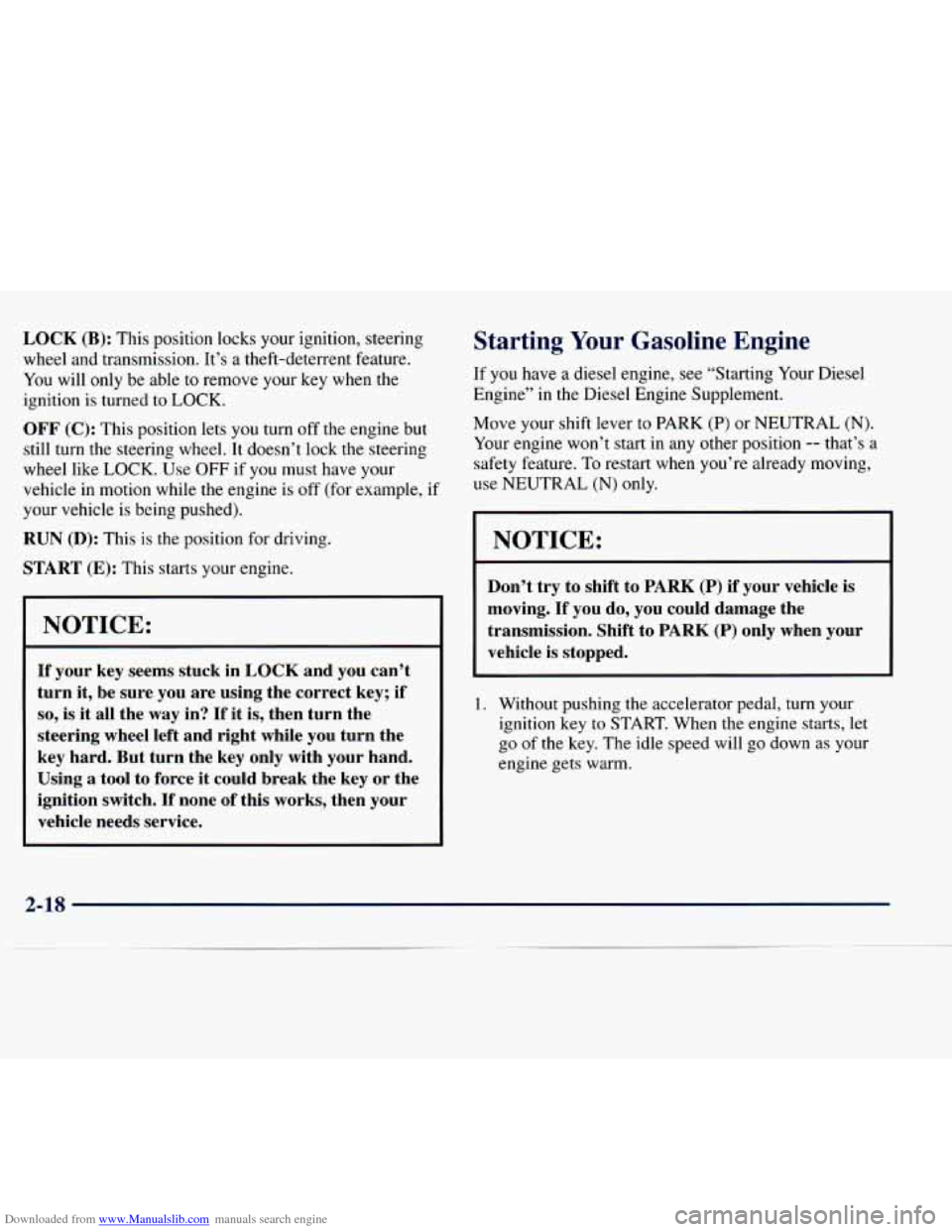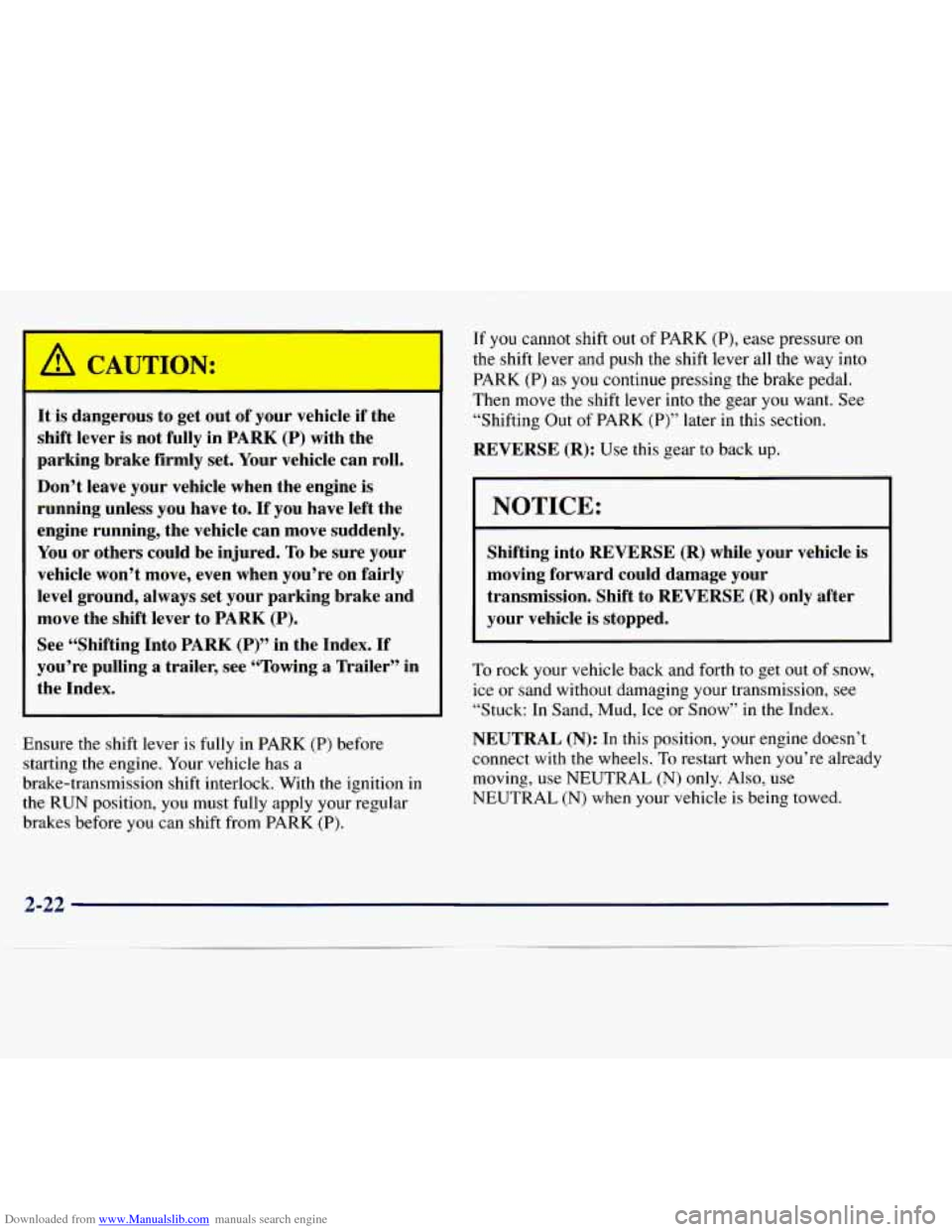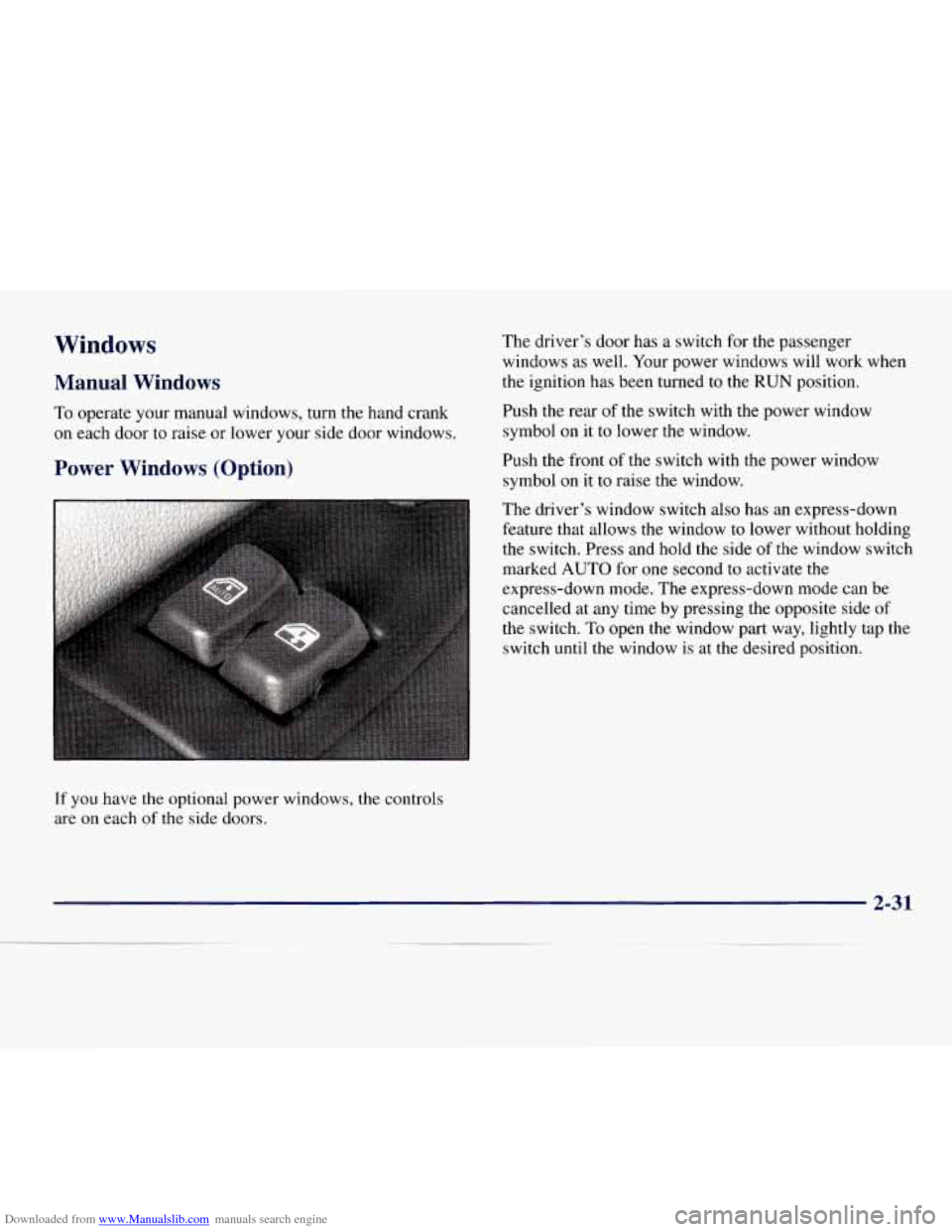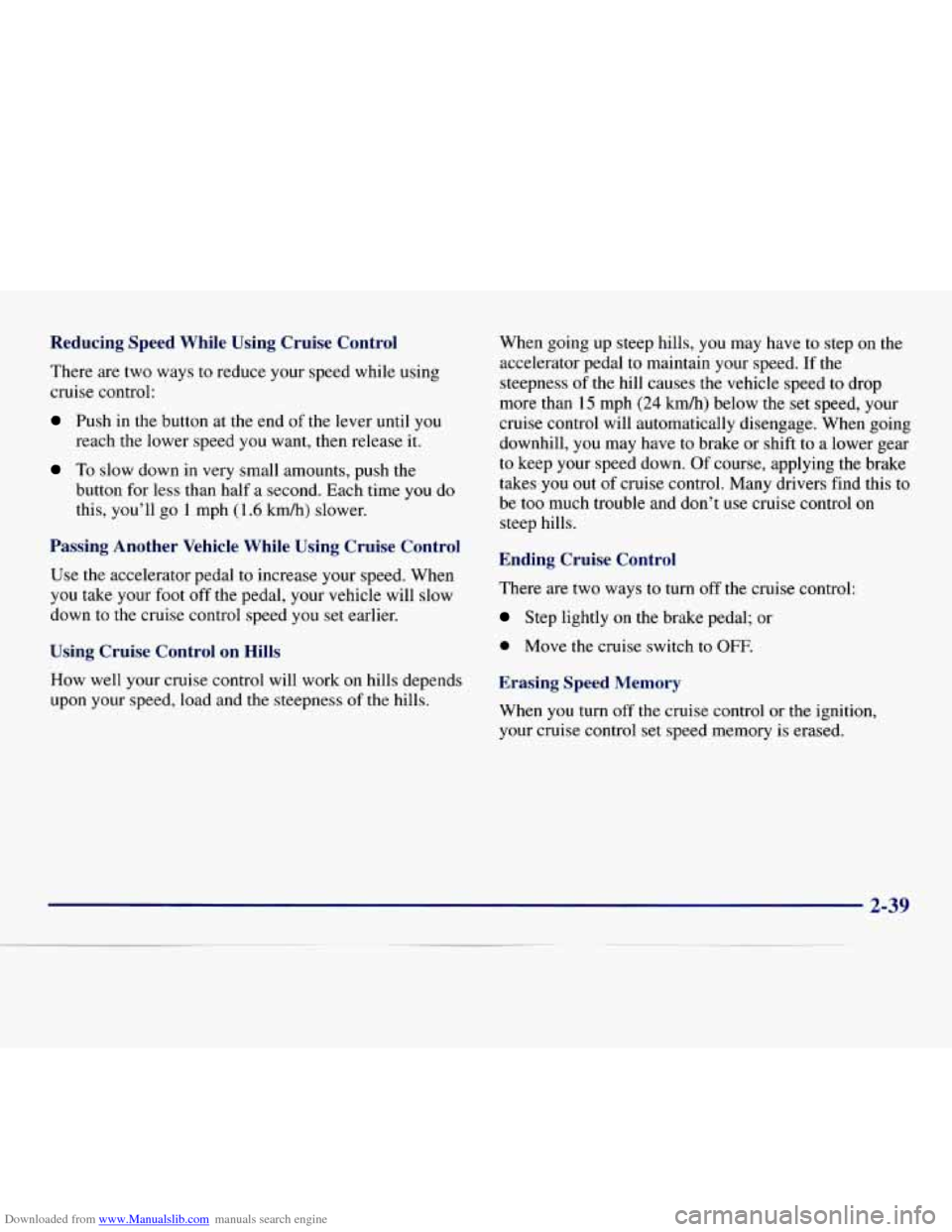Page 89 of 386

Downloaded from www.Manualslib.com manuals search engine LOCK (B): This position locks your ignition, steering
wheel and transmission.
It’s a theft-deterrent feature.
You will only be able to remove your key when the
ignition is turned
to LOCK.
OFF (C): This position lets you turn off the engine but
still
turn the steering wheel. It doesn’t lock the steering
wheel like LOCK. Use
OFF if you must have your
vehicle in motion while the engine is off (for example, if
your vehicle is being pushed).
RUN (D): This is the position for driving.
START (E): This starts your engine.
NOTICE:
If your key seems stuck in LOCK and you can’t
turn
it, be sure you are using the correct key; if
so, is it all the way in? If it is, then turn the
steering wheel left and right while you turn the
key hard. But turn the key only with your hand.
Using
a tool to force it could break the key or the
ignition switch. If none of this works, then your
vehicle needs service.
Starting Your Gasoline Engine
If you have a diesel engine, see “Starting Your Diesel
Engine” in
the Diesel Engine Supplement.
Move your shift lever to
PARK (P) or NEUTRAL (N).
Your engine won’t start in any other position -- that’s a
safety feature. To restart when you’re already moving,
use NEUTRAL
(N) only.
NOTICE:
Don’t try to shift to PARK (P) if your vehicle is
moving. If you do, you could damage the
transmission. Shift to
PARK (P) only when your
vehicle is stopped.
1. Without pushing the accelerator pedal, turn your
ignition key to START. When the engine starts, let
go
of the key. The idle speed will go down as your
engine gets warm.
2-1s
Page 92 of 386

Downloaded from www.Manualslib.com manuals search engine 4. Before starting the engine, be sure to unplug and store
the cord as it was before
to keep it away from moving
engine parts. If you don’t, it could be damaged.
How long should you keep the coolant heater plugged
in? The answer depends on the outside temperature, the
kind of oil
you have, and some other things. Instead of
trying to list everything here, we ask that you contact
your dealer in the area where you’ll be parking your
vehicle. The dealer can give
you the best advice for that
particular area.
Automatic Transmission Operation
There are several different positions for your shift lever.
Your vehicle is equipped with an automatic
transmission, and it features an electronic shift position
indicator within the instrument cluster. This display
must be powered anytime the shift lever is capable of
being moved out of the
PARK (P) position. This means
that
if your key is in the OFF position, but not locked,
there will be a small current drain
on your battery which
could discharge your battery over a period
of time. If
you have a need to leave your key in the ignition in the
OFF position for an extended period for any reason, it is
recommended that
you disconnect the battery cable from
the battery
to prevent discharging your battery.
/DI 3 121 1 vehicle can’t move easily.
PARK (P): This locks your rear wheels. It’s the best
position to
use when you start your engine because your
2-21
Page 93 of 386

Downloaded from www.Manualslib.com manuals search engine It is dangerous to get out of your vehicle if the
shift lever is not fully in
PARK (P) with the
parking brake firmly set. Your vehicle can roll.
Don’t leave your vehicle when the engine is
running unless you have to.
If you have left the
engine running, the vehicle can move suddenly.
You
or others could be injured. To be sure your
vehicle won’t move, even when you’re on fairly
level ground, always set your parking brake and
move the shift lever to
PARK (P).
See “Shifting Into PARK (P)” in the Index. If
you’re pulling a trailer, see “Towing a Trailer” in
the Index.
Ensure the shift lever is fully in PARK (P) before
starting the engine. Your vehicle has a
brake-transmission shift interlock. With the ignition in the RUN position, you must fully apply your regular
brakes before you can shift from PARK (P).
If you cannot shift out of PARK (P), ease pressure on
the shift lever and push the shift lever all the way into
PARK (P) as you continue pressing the brake pedal.
Then move the shift lever into the gear you want. See
“Shifting Out
of PARK (P)” later in this section.
REVERSE (R): Use this gear to back up.
NOTICE:
Shifting into REVERSE (R) while your vehicle is
moving forward could damage your
transmission. Shift to
REVERSE (R) only after
your vehicle is stopped.
To rock your vehicle back and forth to get out of snow,
ice or sand without damaging
your transmission, see
“Stuck: In Sand, Mud, Ice or Snow” in the Index.
NEUTRAL (N): In this position, your engine doesn’t
connect with the wheels.
To restart when you’re already
moving, use NEUTRAL (N) only. Also, use
NEUTRAL (N) when your vehicle is being towed.
2-22
Page 95 of 386
Downloaded from www.Manualslib.com manuals search engine NOTICE:
If your rear wheels can’t rotate, don’t try to
drive. This might happen if you are stuck in very
deep sand or mud or are up against a solid
object. You could damage your transmission.
Also, if you stop when going uphill, don’t hold
your vehicle there with only the accelerator
pedal. This could overheat and damage the
transmission. Use your brakes or shift into
PARK (P) to hold your vehicle in position on
a hill.
Parking Brake
To set the parking brake, hold the regular brake pedal
down with your right foot. Push down the parking brake
pedal with your left foot.
If the ignition is on, the brake system warning light will
come
on.
To release the parking brake, hold the regular brake
pedal down. Pull the handle, located just above the
parking brake pedal, marked
BRAKE RELEASE to
release
the parking brake.
If the ignition is on when the parking brake
is released,
the brake system warning light will
go off.
2-24
Page 97 of 386
Downloaded from www.Manualslib.com manuals search engine 2. Move the shift lever into PARK (P) like this: r
0 Pull the lever toward you.
0 Move the lever up as far as it will go.
3. Move the ignition key to LOCK.
4. Remove the key and take it with you. If you can
leave
your vehicle with the ignition key in your
hand, your vehicle is
in PARK (P).
Page 99 of 386
Downloaded from www.Manualslib.com manuals search engine Shifting Out of PARK (P) If you ever hold the brake pedal down but still can’t
shift out of PARK (P), try this:
Your vehicle has a brake-transmission shift interlock
system. You have to fully apply your regular brakes
1.
before you can shift from PARK (P) when the ignition is 2,
in RUN. See “Automatic Transmission” in the Index. 3.
If you cannot shift out of PARK (P), ease pressure on
the shift lever and push the shift lever all the way up 4.
into PARK (P) as you maintain brake application. Then,
move the shift lever into the gear you want.
5.
Turn the key to OFF.
Apply and hold the brake until the end of Step 4.
Shift to NEUTRAL (N).
Start the vehicle and then shift to the drive gear
you want.
Have the brake-transmission shift interlock system
fixed as soon as
you can.
2-28
Page 102 of 386

Downloaded from www.Manualslib.com manuals search engine Windows
Manual Windows
To operate your manual windows, turn the hand crank
on each door to raise or lower your side door windows.
Power Windows (Option)
If you have the optional power windows, the controls
are
on each of the side doors. The
driver’s door has a switch for the passenger
windows as well. Your power windows will work when
the ignition has been turned to the
RUN position.
Push the rear of the switch with the power window
symbol on it to lower the window.
Push the front of the switch with the power window
symbol
on it to raise the window.
The driver’s window switch also has an express-down
feature that allows the window to lower without holding
the switch. Press and hold the side of the window switch
marked
AUTO for one second to activate the
express-down mode. The express-down mode can be
cancelled at any time by pressing the opposite side of
the switch.
To open the window part way, lightly tap the
switch until the window is at
the desired position.
2-31
Page 110 of 386

Downloaded from www.Manualslib.com manuals search engine Reducing Speed While Using Cruise Control
There are two ways to reduce your speed while using
cruise control:
Push in the button at the end of the lever until you
reach the lower speed you want, then release it.
To slow down in very small amounts, push the
button for less than half a second. Each time
you do
this, you’ll go
1 mph (1.6 kdh) slower. When going up
steep hills, you may have to step
on the
accelerator pedal to maintain your speed. If the
steepness of the hill causes the vehicle speed to drop
more than
15 mph (24 km/h) below the set speed, your
cruise control will automatically disengage. When going
downhill, you may have to brake or shift to a lower gear
to keep your speed down. Of course, applying the brake
takes you out of cruise control. Many drivers find this to
be too much trouble and don’t use cruise control
on
steep hills.
Passing Another Vehicle While Using Cruise Control
Use the accelerator pedal to increase your speed. When
you take your foot
off the pedal, your vehicle will slow
down to the cruise control speed
you set earlier.
Ending Cruise Control
There are two ways to turn off the cruise control:
Step lightly on the brake pedal; or
Using Cruise Control on Hills 0 Move the cruise switch to OFF.
How well your cruise control will work on hills depends
upon your speed, load and the steepness of the hills. Erasing Speed Memory
When you turn off the cruise control or the ignition,
your cruise control set speed memory
is erased.